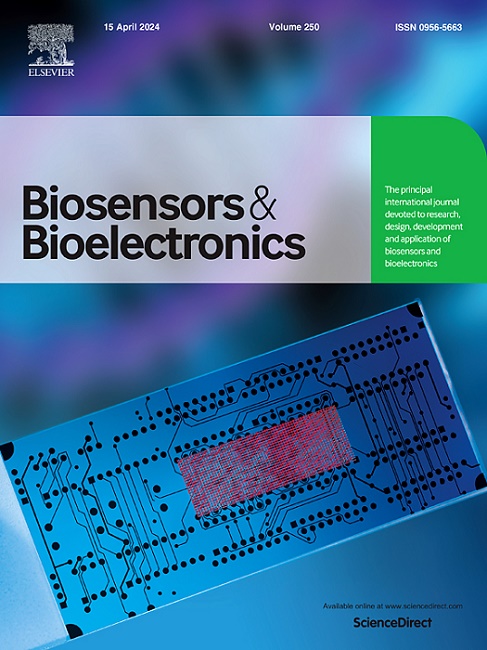Smartphone-deployable and all-in-one machine vision for visual quantification analysis based on distance readout of electrophoresis titration biosensor
IF 10.7
1区 生物学
Q1 BIOPHYSICS
引用次数: 0
Abstract
As a class of point-of-care (POC) assays with visible distance readout (thermometer style), the electrophoresis titration (ET) biosensor affords high robustness, versatility, and simplicity for point-of-care quantification. However, naked-eye observation of the distance readout is unreliable in POC settings and manual processing of distance readout is time-consuming. Herein, we developed a smartphone-deployable and all-in-one machine vision for four ET biosensors (bovine serum albumin, melamine, uric acid, glutathione) to classify and quantify the samples simultaneously. To ensure accurate and rapid quantification on the smartphone, we customized the decolorization methods and edge detection operators to balance the region of interest (ROI) extraction performance and processing speed. We then established a dataset of 180 distance readout images to endow our machine vision with the ability to classify four sample types. Consequently, our machine vision demonstrated high accuracy in determining the sample type (>97.2%) and concentration (>97.3%). Moreover, expanding its applications to other targets was readily achieved by including distance readout images of other ET biosensors (e.g., hemoglobin A1c) in the dataset. Therefore, our strategy of constructing machine vision is compatible with the versatile ET biosensor technique, suggesting that the same strategy can be used for other thermometer-style POC assays.
基于电泳滴定生物传感器距离读数的可部署智能手机的一体化机器视觉视觉定量分析。
电泳滴定(ET)生物传感器是一类具有可视距离读数(温度计式)的床旁(POC)检测方法,具有高稳定性、多功能性和简便性,可用于床旁定量检测。然而,在 POC 环境中,肉眼观察距离读数并不可靠,而且手动处理距离读数非常耗时。在此,我们为四种 ET 生物传感器(牛血清白蛋白、三聚氰胺、尿酸、谷胱甘肽)开发了一种可在智能手机上部署的一体化机器视觉,可同时对样品进行分类和定量。为确保在智能手机上进行准确、快速的定量,我们定制了脱色方法和边缘检测算子,以平衡感兴趣区(ROI)提取性能和处理速度。然后,我们建立了一个包含 180 幅距离读出图像的数据集,赋予机器视觉对四种样品类型进行分类的能力。因此,我们的机器视觉在确定样品类型(>97.2%)和浓度(>97.3%)方面表现出了很高的准确性。此外,通过将其他 ET 生物传感器(如血红蛋白 A1c)的距离读出图像纳入数据集,还可将其应用扩展到其他目标。因此,我们构建机器视觉的策略与多功能 ET 生物传感器技术是兼容的,这表明同样的策略可用于其他温度计式 POC 检测。
本文章由计算机程序翻译,如有差异,请以英文原文为准。
求助全文
约1分钟内获得全文
求助全文
来源期刊

Biosensors and Bioelectronics
工程技术-电化学
CiteScore
20.80
自引率
7.10%
发文量
1006
审稿时长
29 days
期刊介绍:
Biosensors & Bioelectronics, along with its open access companion journal Biosensors & Bioelectronics: X, is the leading international publication in the field of biosensors and bioelectronics. It covers research, design, development, and application of biosensors, which are analytical devices incorporating biological materials with physicochemical transducers. These devices, including sensors, DNA chips, electronic noses, and lab-on-a-chip, produce digital signals proportional to specific analytes. Examples include immunosensors and enzyme-based biosensors, applied in various fields such as medicine, environmental monitoring, and food industry. The journal also focuses on molecular and supramolecular structures for enhancing device performance.
 求助内容:
求助内容: 应助结果提醒方式:
应助结果提醒方式:


